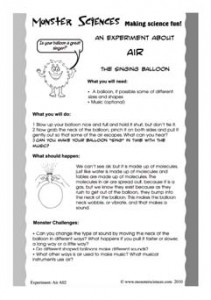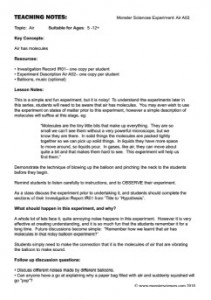Learn all about molecules in air with this fun (and noisy) science experiment and lesson plan.
 |
 |
Air Science Experiment: The Singing Balloon
What you will need:
• A balloon, if possible some of different sizes and shapes
• Music (optional)
What you will do:
- Blow up your balloon nice and full and hold it shut, but don’t tie it.
- Now grab the neck of the balloon, pinch it on both sides and pull it gently out so that some of the air escapes. What can you hear?
- Can you make your balloon “sing” in time with the music?
What should happen:
We can’t see air, but it is made up of molecules, just like water is made up of molecules and tables are made up of molecules. The molecules in air are spread out, because it is a gas, but we know they exist because as they rush to get out of the balloon, they bump into the neck of the balloon. This makes the balloon neck wobble, or vibrate, and that makes a sound.
Monster Challenges:
- Can you change the type of sound by moving the neck of the balloon in different ways? What happens if you pull it faster or slower, a long way or a little way?
- Do different shaped balloons make different sounds?
- What other ways is air used to make music? What musical instruments use air?
TEACHING NOTES:
Topic:
Air
Key Concepts:
Air has molecules
Resources:
• Investigation Record IR01– one copy per student
• Experiment Description Air A02– one copy per student
• Balloons, music (optional)
Lesson Notes:
This is a simple and fun experiment, but it is noisy! To understand the experiments later in this series, students will need to be aware that air has molecules. You may even wish to use the experiment on states of matter prior to this experiment, however a simple description of
molecules will suffice at this stage, eg:
“Molecules are the tiny little bits that make up everything. They are so small we can’t see them without a very powerful microscope, but we
know they are there. In solid things the molecules are packed tightly together so we can pick up solid things. In liquids they have more space
to move around, so liquids pour. In gases, like air, they can move about quite a bit and that makes them hard to see. This experiment will help us
find them.”
Demonstrate the technique of blowing up the balloon and pinching the neck to the students before they begin.
Remind students to listen carefully to instructions, and to OBSERVE their experiment.
As a class discuss the experiment prior to undertaking it, and students should complete the sections of their Investigation Report IR01 from ”Title to “Hypothesis”.
What should happen in this experiment, and why?
A whole lot of lets face it, quite annoying noise happens in this experiment. However it is very effective at creating understanding, and it is so much fun that the students remember it for a long time. Future discussions become simple: “Remember how we learnt that air has molecules in that noisy balloon experiment?”
Students simply need to make the connection that it is the molecules of air that are vibrating the balloon to make sound.
Follow up discussion questions:
• Discuss different noises made by different balloons.
• Can anyone have a go at explaining why a paper bag filled with air and suddenly squished will go “pop”?
© www.monstersciences.com




